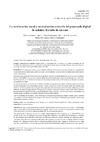Please use this identifier to cite or link to this item:
http://hdl.handle.net/10553/37145
| Title: | La reeducación vocal y su evaluación a través del procesado digital de señales: Estudio de un caso | Other Titles: | Voice re-education and its evaluation through digital signal processing: A case study | Authors: | Santana López, María Zulema Domínguez Jaén, Óscar Alonso Hernández, Jesús Bernardino Mato Carrodeguas, María del Carmen |
UNESCO Clasification: | 610205 Patología del lenguaje 610308 Rehabilitación |
Keywords: | Voice Vocal rehabilitation Vocal technique Cimardi Method: the cellophane screen Neurodegenerative disease, et al |
Issue Date: | 2017 | Journal: | Loquens | Abstract: | Las patologías vocales, ya sean debidas a disfonías funcionales o a lesiones orgánicas o, simplemente, a una emisión de voz inadecuada, pueden dar lugar a un forzamiento vocal que afecta de manera importante al proceso de comunicación.El estudio que se presenta se basa en el caso de una única paciente con un diagnóstico de miastenia gravis (enfermedad de Erb-Goldflam). En este caso concreto, dicha afección ha dado lugar, entre otras perturbaciones, a una disartria. Para tratarla, se ha utilizado una técnica de educación y reeducación vocal basada en un elemento resonador: una pantalla de celofán.En el presente artículo se muestran los resultados obtenidos en la paciente tras aplicar una técnica pionera en el campo de la reeducación vocal denominada método Cimardi: Pantalla de Celofán. Se han estudiado los cambios en la señal de voz de la paciente antes y después de la aplicación del mencionado método Cimardi, utilizando para ello diferentes dominios de representación: el temporal, el espectral y el cepstral. Además, se han usado distintos parámetros para medir la calidad de la voz, como por ejemplo el shimmer, el jitter o el harmonic-to-noise ratio (HNR), con el fin de poder cuantificar los resultados obtenidos con el método Cimardi.Una vez analizados los resultados, se ha observado que la técnica empleada por el método Cimardi ayuda a producir una emisión vocal más natural y libre, lo que resulta muy útil como terapia rehabilitadora para aquellas personas que sufren ciertos trastornos vocales. Voice re-education and its evaluation through digital signal processing: A case study. – Voice pathologies, caused either by functional dysphonia or organic lesions, or even by just an inappropriate emission of the voice, may lead to vocal abuse, affecting significantly the communication process.The present study is based on the case of a single patient diagnosed with myasthenia gravis (Erb-Goldflam syndrome). In this case, this affection has caused, among other disruptions, a dysarthria. For its treatment, a technique for the education and re-education of the voice has been used, based on a resonator element: the cellophane screen. This article shows the results obtained in the patient after applying a vocal re-education technique called the Cimardi Method: the Cellophane Screen, which is a pioneering technique in this field. Changes in the patient’s voice signal have been studied before and after the application of the Cimardi Method in different domains of study: time-frequency, spectrum, and cepstrum. Moreover, parameters for voice quality measurement, such as shimmer, jitter and harmonic-to-noise ratio (HNR), have been used to quantify the results obtained with the Cimardi Method.Once the results were analyzed, it has been observed that the Cimardi Method helps to produce a more natural and free vocal emission, which is very useful as a rehabilitation therapy for those people presenting certain vocal disorders. |
URI: | http://hdl.handle.net/10553/37145 | ISSN: | 2386-2637 | DOI: | 10.3989/loquens.2017.040 | Source: | Loquens [ISSN 2386-2637], v. 4 (1), article number e040 |
| Appears in Collections: | Artículos |
Page view(s)
247
checked on Apr 27, 2024
Download(s)
126
checked on Apr 27, 2024
Google ScholarTM
Check
Altmetric
Share
Export metadata
Items in accedaCRIS are protected by copyright, with all rights reserved, unless otherwise indicated.
